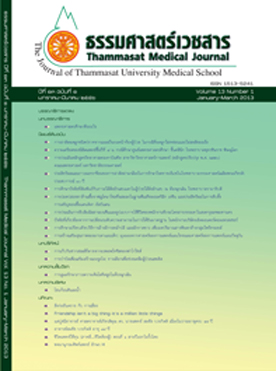The effects of different washing procedures on pyrethroid residues in cabbage and chinese cabbage
Keywords:
ไพรีทรอยด์, ปริมาณสารพิษตกค้างสูงสุด, สัดส่วนความเสี่ยง, Pyrethroid, Maximum residue limit (MRL), Hazard quotientAbstract
Introduction: Thai farmers still give their trust on pesticides. The import tendency was increased every year.The examination result showed the high concentration of residues in vegetable due to the wrong carelessusage.
Method: Thirty cabbages and thirty chinese cabbages were purposely selected from Talad Thai, Talad Simummuangand Talad Klongtoey during November 2010 to January 2011, pyrethroid residues were extracted fromthe samples and compared with maximum residue limits (MRL) of Thailand. Qualitative and quantitativeanalysis were performed by using gas chromatography-mass spectrometer (GC-MS). Comparative studyof three different washing procedures on pyrethroid residues in both kinds of cabbages was presented.
Result: The average amount of lambda-cyhalothrin, cypermethrin, fenvalerate and deltamethrin found in unwashedcabbages were 0.135, 0.468, 0.687 and 0.104 mg/kg, respectively. Less than 10% of these cabbagesshowed that pyrethroid residue concentration was over MRL. Simi larly, the average amount oflambda-cyhalothrin, cypermethrin, fenvalerate and deltamethrin found in Chinese cabbages were 0.122,0.535, 0.403 and 0.268 mg/kg, respectively. Less than 10% of Chinese cabbages showed that pyrethroidresidue concentration was also over MRL.
Conclusion: The three different washing procedures on pyrethroid residues in both cabbages were steeping indeionized water, steeping in lime water with volume ratio of 1:1 and 0.001% w/v potassium permanganatewater. It was found that potassium permanganate water was the most effective washing, lime water wasthe second and deionized water was the last choice. The calculated hazard quotients of both cabbageswere less than one. This indicated that the dietary exposure of pyrethroid residues was still in a safelevel for all 8 age-groups (infant through elder group).
Key words: Pyrethroid, Maximum residue limit (MRL), Hazard quotient



